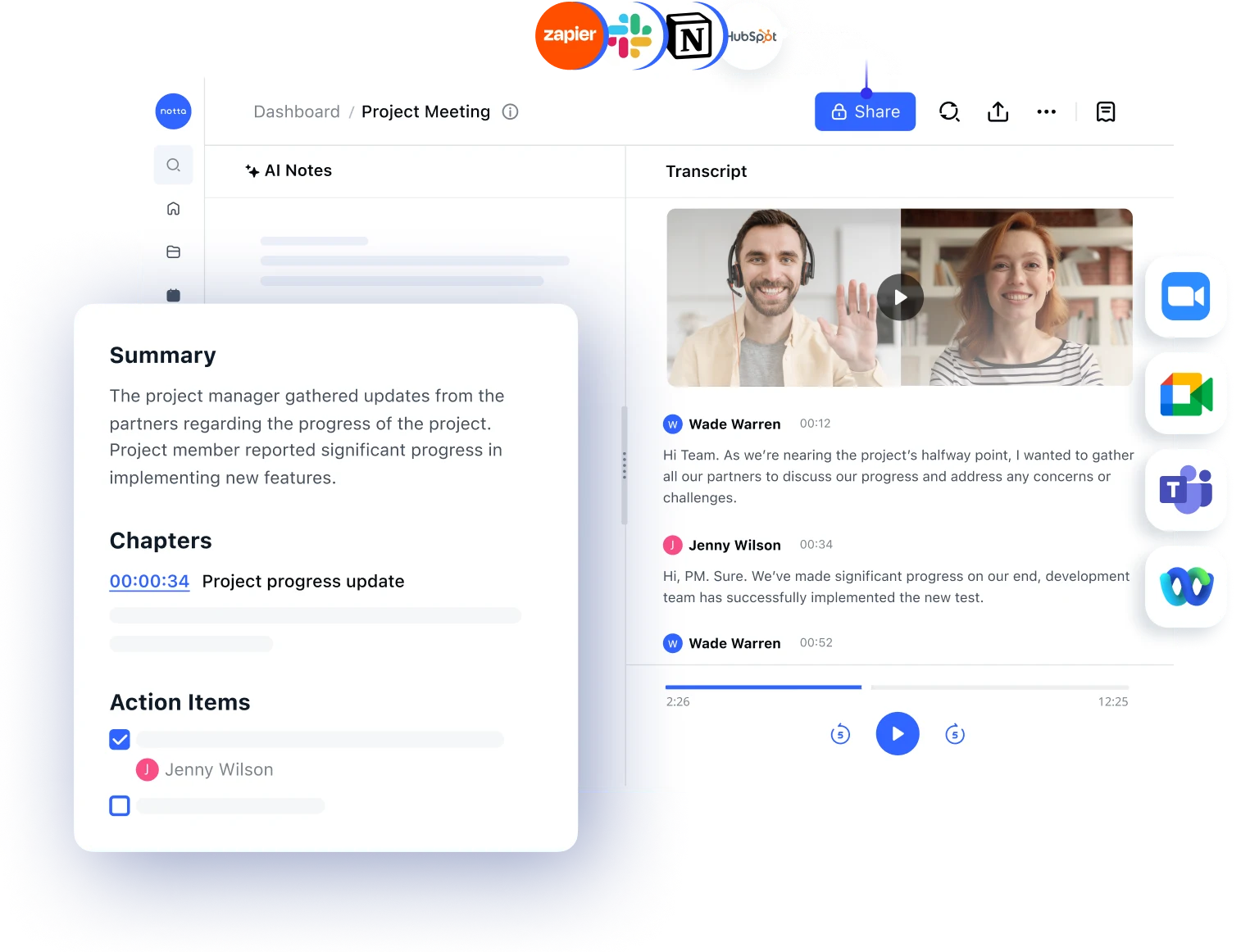Have you ever received a meeting invitation but felt confused because there is not any additional information? Or worse yet, have you ever been the meeting organizer that failed to achieve its intended purpose?
If the answer is yes, then a well-crafted meeting memo can make all the difference. This crucial step is the backbone of successful meetings by ensuring alignment and preparedness.
In this article, we’ll provide a step-by-step guide on how to write a memo for a meeting with a meeting memo example to kickstart your memo-writing journey. Whether you're a seasoned professional or a corporate world novice, this article will enhance your memo-writing skills. Let's dive in!
What is a memo in a meeting?
A meeting memorandum is a short but informational message sent to participants of the upcoming meeting. It serves as a reminder and guide for the attendees, and provides crucial information like the meeting’s objectives, time, and location, thus ensuring everyone is informed and prepared for the meeting.
To be more specific, a meeting memo typically addresses the five Ws:
Who is involved in the discussion? Who are the attendees, and who is responsible for specific tasks or presentations?
What is the meeting about? What are the key topics or agenda items?
Where will the session take place? Is it a physical location or a virtual meeting with a specific link or platform?
When is the meeting scheduled? When are particular items on the agenda due to start and end?
Why is the meeting necessary? Why is each agenda item essential, and why should attendees care?
A staff meeting memo is usually sent via email. However, the delivery medium can vary depending on the organization’s size, structure, and internal communication norms. Whether it’s a traditional paper memo circulated in a small office or a digital memo distributed across global teams, the purpose remains to inform and align. If you hand out physical copies instead of sending emails, ensure they are easily accessible and visible to recipients.
How to write an effective meeting memo?
Crafting a meeting memo might seem straightforward, however, condensing all necessary details into a concise and compelling memo can be challenging and you need some training. Below are several vital steps to follow.
1. Craft a clear subject line
A clear and concise subject line serves as the first point of contact and sets the stage for the information that follows. It should accurately reflect the memo’s content and capture the recipient’s attention.
The best format is to state that this is a memo for the specific scheduled meeting. For example, “Staff Meeting Memo: Q2 Financial Review - May 15”. It is concise, informative, and straightforward.
2. Address the recipients appropriately
This is the part where you establish your audience. Whether it’s a broad group like ‘All Staff’ or a specific team like ‘Marketing Team,’ ensure that you address your recipients appropriately. The level of formality will depend on your organization’s culture and the memo’s purpose.
3. Provide the meeting details
After addressing your recipients, dive into the meeting's purpose and logistics. Be precise and articulate, leaving no room for misinterpretations.
First, specify the logistics — the meeting's date, time, and location (or platform). This helps avoid any confusion about when and where the meeting will occur. Whether it's a physical location for in-person sessions or a platform for virtual meetings, providing this information upfront allows attendees to plan their day and ensures they show up at the right place and time.
Next, explain the purpose of this meeting and inform recipients why they must attend the meeting and the topics for discussion, enabling them to prepare in advance. Doing this aligns everyone's expectations, laying the groundwork for a productive meeting.

4. Include any necessary preparatory steps
If there are tasks or information that recipients need to prepare before the meeting, mention these in the memo.
For example, “Please come prepared with your department’s sales figures for Q2 and any challenges you faced.”
This strategy ensures a smooth progression of the meeting. By requesting attendees to prepare in advance, you’re encouraging them to actively participate in the meeting rather than merely being passive listeners.
Moreover, when individuals come prepared, they are more likely to contribute meaningful insights, fostering a more collaborative and productive discussion.
5. Ask for confirmation
Once you’ve given all the necessary information, it’s time to ask for confirmation. For example, “Please confirm your attendance by [date] so we can ensure all arrangements are made.”
Requesting confirmation of attendance is critical because it enables the organizer to understand who will be present, allowing for any necessary adjustments in the meeting’s scope or content.
It also helps with logistical planning, like setting up a meeting room or ensuring the virtual platform can accommodate all attendees.
6. Include instructions
The memo should clearly state any specific instructions related to the meeting. This could include details about accessing a virtual meeting room, protocols for entering a physical meeting space, or expectations about punctuality.
For example, “For those attending virtually, please log in 5 minutes early to ensure a timely start. The link for the meeting is [insert link].” These instructions help attendees plan their participation and ensure the meeting starts on time and runs smoothly.
Capture every detail with AI meeting notes
Notta offers the most integrated AI meeting notes, summaries, and action items so nothing gets missed.
Tips for a successful staff meeting memo
Beyond the basic steps of writing a staff meeting memo, these additional tips can make your memo more effective:
Timely distribution: Send your meeting memo email at least one day in advance, giving your team time to prepare and manage their schedules. It ensures maximum participation and readiness for the meeting.
Be concise yet comprehensive: Provide essential details without overwhelming your team. Keep your memo brief and focused so critical information doesn't get lost in a sea of words.
Format for clarity: Organize your memo with bullet points, numbers, or headings for easy scanning. Well-structured information is more likely to be retained, leading to a more effective meeting.
Use an active voice: Use an active voice for engagement and immediacy. It brings life to your message and emphasizes action, turning a passive audience into active participants.
Follow-up: Follow up with those who haven’t confirmed attendance after sending the memo. This serves two primary purposes: ensuring the memo was received and understood and reminding attendees of the upcoming meeting. This step is instrumental when confirmations are slow to come in or if there are updates to the meeting details. Follow-ups demonstrate your commitment to the meeting’s success and can help boost attendance.
Meeting memo example
Translating theory into practice is often the best way to understand a new concept. With that in mind, let’s consider an example of a well-written meeting memo.
This example will demonstrate how all the tips and steps we’ve discussed come together to form a clear, concise, and practical memo for a meeting. Remember, while this is a model to guide you, adapting your memo to fit your organization’s unique culture and communication style is crucial.
Now, let’s dive into the example.
From: [Your Name]
To: All Team Members
Date: July 7, 2023
Subject: Q2 Performance Review
Dear Team,
As the seasons change, it's time for us to gather, reflect, and strategize. I am calling a staff meeting on July 14, 2023, at 2:00 PM in the main conference room.
This meeting will discuss our performance over the past quarter, identify challenges, celebrate successes, and plan for the upcoming quarter. Your participation is pivotal.
I will distribute a detailed Q2 report by July 12 to allow you enough time to review and prepare your thoughts.
Should you wish to discuss any specific topics during the meeting, please email them to me by July 11. We aim to address all concerns in this meeting. Please confirm your attendance by replying to this memo.
Let's make this meeting as harmonious and productive as an orchestra creating beautiful music. Thank you for your ongoing dedication and hard work.
Best,
[Your Name]
[Your Position]
Meeting memo templates to get started
The above “meeting memo example” might inspire you to create your own. Here are two simple yet effective meeting memo templates to aid you in this journey. These will serve as a solid foundation for building your personalized meeting memos.
Template 1: Business meeting memo template
From: [Name]
To: [Team Members]
Date: [Date]
Subject: [What the meeting is about]
Dear Team,
We will be holding a crucial business meeting on [date] at [time] in [location/platform].
This meeting aims to [explain the purpose of the meeting].
[Any additional information you’d like the attendees to know or prepare].
Please confirm your attendance by replying to this memo. Your insights and input are vital to our collective success.
Best,
[Your Name]
[Your Position]
Template 2: Progress report meeting memo template
From: [Your Name]
To: [Project Team]
Date: [Date]
Subject: Project Progress Meeting - [Project Name]
Dear Team,
We have scheduled a progress report meeting for [Project Name] on [date] at [time] in [location/platform].
The meeting will evaluate our progress … [why this meeting is held].
Please come prepared to discuss [Any preparation or report]
Kindly confirm your attendance by replying to this memo. Your active involvement is critical to our project's success.
Best,
[Your Name]
[Your Position]
Mastering the art of effective meeting memos
Navigating the world of professional communication can often feel like walking on a tightrope, especially when tasked with drafting a meeting memo. Remember, this memo is much more than a simple notification. It serves as a beacon, illuminating the path to success by ensuring everyone in the organization is aligned and informed.
So, as you compose your next meeting memo, apply the tips and guidelines in this article, and create an engaging, informative memo that drives productivity and cohesion in your work environment.
More productive meetings, with Notta
Fully customizable scheduling, live meeting notes, and ready-to-use AI summary templates to streamline and automate your meeting processes.

